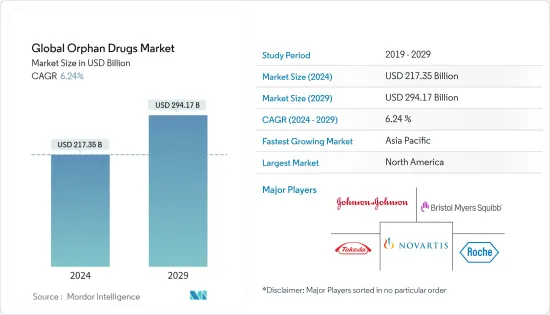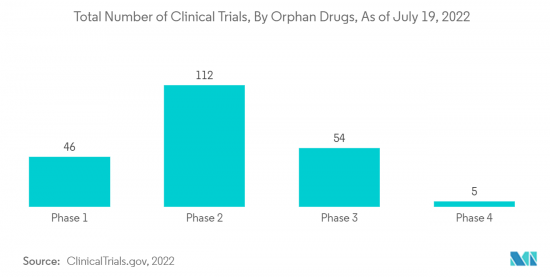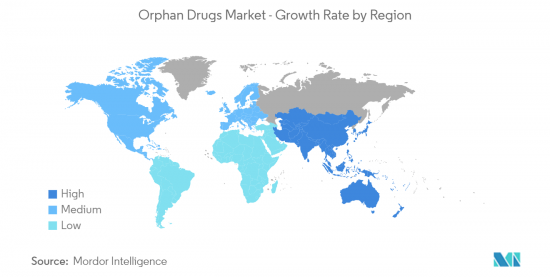
|
市場調査レポート
商品コード
1429475
世界の希少疾病用医薬品:市場シェア分析、産業動向と統計、成長予測(2024年~2029年)Global Orphan Drugs - Market Share Analysis, Industry Trends & Statistics, Growth Forecasts (2024 - 2029) |
||||||
カスタマイズ可能
適宜更新あり
|
|||||||
| 世界の希少疾病用医薬品:市場シェア分析、産業動向と統計、成長予測(2024年~2029年) |
|
出版日: 2024年02月15日
発行: Mordor Intelligence
ページ情報: 英文 120 Pages
納期: 2~3営業日
|
- 全表示
- 概要
- 目次
希少疾病用医薬品の世界市場規模は、2024年に2,173億5,000万米ドルと推計され、2029年には2,941億7,000万米ドルに達し、予測期間(2024~2029年)のCAGRは6.24%で成長すると予測されます。

COVID-19の大流行は前例のない公衆衛生上の懸念であり、社会的排除により病院やヘルスケアサービスが著しく抑制され、サプライチェーンが阻害されたため、世界の希少疾病用医薬品市場に大きな影響を与えました。2020年9月、COVID-19を希少疾病として扱うことは「不誠実」であるとの批判を受け、米国食品医薬品局(FDA)はギリアド・サイエンシズ社のCOVID-19の治療薬候補から希少疾病用医薬品の指定を取り下げました。このような事例は、パンデミック時の市場成長を妨げる可能性があります。このように、パンデミックは調査対象市場に大きな影響を与えると予想されます。
この市場の成長をもたらす要因としては、希少疾病治療薬開発企業に対する市場独占権、希少疾病の新興国市場開拓、有利な政府政策などが挙げられます。
近年、世界人口の間で希少疾患の有病率が増加しています。この問題に取り組むため、新興諸国も先進諸国も、希少疾患治療薬の開発を促進する規定を策定し、これらの治療薬が患者にとって容易に入手できるようにしています。2022年5月のGARD(Genetic and Rare Diseases)情報センターによると、アメリカ人の10人に1人(3,000万人)が希少疾病に罹患しており、約7,000の希少疾病が知られています。さらに、「GlobalGenes」が2021年9月に更新したデータによると、世界中で4億人以上が希少疾患の影響を受けています。希少疾患の80%は遺伝学的起源が特定されています。加えて、2022年3月に発表された「希少疾患:勢いの維持」と題された調査によると、2021年に製薬会社が希少疾患の研究に費やした総額は229億米ドルで、2020年から28%増加しています。このように、希少疾患に対する有病率の高まりと研究開発費の増加は、革新的な希少疾病治療薬にチャンスをもたらしています。そのため、分析期間(2022-2027年)の市場成長を押し上げると予想されます。
さらに、希少疾病用医薬品の承認と生産に関する政府の有利な政策が市場の成長を支えています。オーファンドラッグ法(ODA)が十分に認知されている国には、米国、日本、オーストラリア、欧州などがあります。国民の約99%が健康保険に加入している日本は、最近、患者数5万人未満から18万人未満に希少疾病用医薬品の基準を拡大し、患者、支払者、医療提供者に希少疾病に対する成功の機会を提供しています。欧州では、欧州医薬品庁(EMA)が希少疾病用医薬品の開発と認可を促進する中心的な機関です。最近5年間の承認件数は、EU全体で一貫して高い水準にあります。
また、希少疾患に対する新たな治療法の開発における研究開発活動の活発化も、市場の成長を後押ししています。例えば、2021年12月のClinicalTrails.govによると、Assistance Publique-Hopitaux de Parisによる調査中の「希少疾患患者の口腔保健関連QOL:定性的アプローチ(RaroDentAXE3)」と題する研究は、2022年12月までに完了する見込みです。このように、希少疾患に関する研究の増加は、予測期間中の市場成長を押し上げると予想されます。
このように、前述のすべての要因が予測期間中の市場成長を押し上げると予想されます。しかし、臨床試験やマーケティングのための患者数は限られており、市場成長の抑制要因となっています。
希少疾病用医薬品市場の動向
神経疾患領域は予測期間中に成長が見込まれる
神経疾患は希少疾患の約半数を占めます。スクリーニング検査やゲノム配列の診断、専門的な臨床知識が不足しているため、希少な中枢神経系(CNS)疾患の特定や治療は困難な場合が多いです。希少疾患は約5,000~8,000種類あります。神経疾患には、反射性交感神経性ジストロフィー症候群、バターリャ・ネリ症候群、クロイツフェルト・ヤコブ病、失認、アイカルディ症候群、アイカルディ・グティエール症候群などがあります。2022年1月に発表された「希少疾患の有病率と発生率:書誌データ」と題された報告書によると、慢性炎症性脱髄性多発神経障害の有病率はヨーロッパで3.7となっています。しかし、希少神経疾患の診断には、住民の希少神経疾患に対する認識不足など、いくつかの障壁があります。希少疾患は、世界中で大きなヘルスケアと経済的負担を生み出しています。
2020年6月に更新された全米希少疾患機構(NORD)のデータでは、7,000以上の希少疾患が存在し、3,000万人以上のアメリカ人が罹患していると推定されています。さらに、そのうちの約3分の1が神経学的要素や症状を含むと考えられています。加えて、2021年1月に希少神経疾患研究センターが発表したデータによると、希少神経疾患は米国で約20万人に影響を及ぼしています。このように、希少神経疾患の負担増が希少疾病用医薬品の需要を押し上げています。
2021年7月にOrphanet of the Rare Diseasesに掲載された「希少疾患治療薬開発の動向を説明するためのFDAによる40年間の希少疾患治療薬指定:希少な腫瘍性疾患、神経疾患、小児発症疾患の治療薬開発に見られる大幅な成長」と題する研究によると、希少疾患治療薬指定の上位3つの治療カテゴリーは、腫瘍(1910、37%)、神経(674、13%)、感染症(436、9%)でした。
さらに、オーファンドラッグに対する食品医薬品局(FDA)の承認の拡大は、セグメントの成長を後押しすると予想されています。例えば、2021年11月、PharmaTher Holdings Ltd.は、発作の緊急治療を必要とする稀な神経疾患であるてんかん状態を治療するためのケタミンについて希少疾病用医薬品の指定('ODD')を受ける予定です。
これらの前述されたすべての要因が予測期間中の同分野の成長を後押しすると予想されます。

北米が市場を独占、予測期間中も同様と予想
北米は現在、希少疾病用医薬品(オーファンドラッグ)市場を独占しており、今後もその牙城は揺るがないと予想されます。北米地域では米国が最大の市場シェアを占めています。米国では、希少疾病用医薬品(オーファンドラッグ)に指定された医薬品は、特定の適応症についてFDAの承認を受けると7年間の販売独占権、税額控除や使用料免除が受けられ、これが市場成長の理由のひとつとなっています。
さらに、遺伝性希少疾患情報センター(GARD)が2022年5月に更新したデータによると、希少疾患は約3,000万人の米国人に見られ、カナダ希少疾患機構(CORD)の2021年更新データによると、310万人のカナダ人に見られます。アメリカでは有病率が高いため、政府は研究助成金や基金を通じて希少疾患患者を支援しています。FDAが承認した治療法がある希少疾患はわずか5%であることから、NIHは2019年から2020年にかけて、希少疾患の研究に3,100万米ドルの助成金を提供しました。同様に、2020年10月、食品医薬品局(FDA)は希少医薬品法を実施し、今後4年間の6つの臨床試験研究のために1,600万米ドル以上を産業および学界に授与しました。
さらに、希少疾病用医薬品に指定された医薬品の増加が市場成長を後押しすると予想されています。例えば、2020年6月、Agios Pharmaceuticals Inc.は、同社のパイプライン候補であるサラセミア治療薬ミタピバットについて、米国食品医薬品局(FDA)から希少疾病用医薬品の指定を受けました。2020年5月には、アストラゼネカと第一三共が、胃食道接合部がんを含む胃がん患者を対象としたエンヘルトゥ(トラスツズマブ・デルクステカン)について、米国食品医薬品局(FDA)から希少疾病用医薬品の指定を受けました。
これらことから、希少疾病用医薬品市場は北米地域で成長すると予測されています。

希少疾病用医薬品業界の概要
希少疾病用医薬品市場の競争は中程度です。市場シェアの面では、現在、少数の大手企業が市場を独占しています。疾病数の増加と毎年の症例数の増加に伴い、少数の中小企業が市場に参入し、かなりのシェアを占めています。市場参入企業には、Celgene Corporation、Takeda Pharmaceutical Company Limited、Novartis AG、Johnson & Johnson、F. Hoffmann-La Roche Ltdなどがあります。
その他の特典
- エクセル形式の市場予測(ME)シート
- 3ヶ月間のアナリストサポート
目次
第1章 イントロダクション
- 調査の前提条件と市場定義
- 調査範囲
第2章 調査手法
第3章 エグゼクティブサマリー
第4章 市場力学
- 市場概要
- 市場促進要因
- 希少疾病用医薬品開発企業の市場独占権
- 希少疾患の増加
- 有利な政府政策
- 市場抑制要因
- 患者一人当たりの治療費が高い
- 臨床試験および製品マーケティングのための限られた患者数
- ポーターのファイブフォース分析
- 新規参入業者の脅威
- 買い手/消費者の交渉力
- 供給企業の交渉力
- 代替品の脅威
- 競争企業間の敵対関係の強さ
第5章 市場セグメンテーション
- 薬剤タイプ別
- 生物学的製剤
- 非生物学的製剤
- 売れ筋医薬品別
- レブリミド
- ダルザレックス
- リツキサン
- タフィンラー
- ニンラーロ
- インブルビカ
- ミオザイム
- ソリリス
- ジャカフィ
- カイプロリス
- その他の売れ筋医薬品
- 疾患タイプ別
- 腫瘍
- 血液
- 神経
- 循環器
- その他の疾患
- 地域
- 北米
- 米国
- カナダ
- メキシコ
- 欧州
- ドイツ
- 英国
- フランス
- イタリア
- スペイン
- その他欧州
- アジア太平洋
- 中国
- 日本
- インド
- オーストラリア
- 韓国
- その他アジア太平洋地域
- 中東・アフリカ
- GCC
- 南アフリカ
- その他中東とアフリカ
- 南米
- ブラジル
- アルゼンチン
- その他南米
- 北米
第6章 競合情勢
- 企業プロファイル
- Alexion Pharmaceuticals
- Bristol-Myers Squibb Company(Celgene Corporation)
- Novartis AG
- Pfizer Inc.
- F. Hoffmann-La Roche Ltd
- Takeda Pharmaceutical Company Limited
- Amgen Inc.
- Sanofi S.A
- Johnson & Johnson
- AstraZeneca Plc
- AbbVie Inc.
- GlaxoSmithKline Plc
- Daiichi Sankyo Company Limited
- Bayer AG
第7章 市場機会と今後の動向
The Global Orphan Drugs Market size is estimated at USD 217.35 billion in 2024, and is expected to reach USD 294.17 billion by 2029, growing at a CAGR of 6.24% during the forecast period (2024-2029).

The COVID-19 outbreak is an unprecedented public health concern that has had a significant impact on the orphan drug market globally as hospital and healthcare services were severely curtailed due to social exclusion and the supply chain was hampered. In September 2020, following criticism that treating covid-19 as a rare disease was "disingenuous," the United States Food and Drug Administration (FDA) has withdrawn orphan drug designation from a potential treatment for covid-19 from Gilead Science. Such instances may hamper the market growth during the pandemic. Thus, the pandemic is anticipated to have a significant impact on the studied market.
Some of the factors that are responsible for the growth of this market include market exclusivity for orphan drug developers, the rising prevalence of rare diseases, and favorable government policies.
Globally, the prevalence of rare diseases among the global population has been increasing in recent years. To tackle this issue, both developing and developed countries have formulated regulations that promote the development of drugs for rare diseases, as well as make sure that these drugs are easily availRare diseases: maintaining momentumable to patients. According to the Genetic and Rare Diseases (GARD) Information Center in May 2022, 1 in 10 Americans (or 30 million people) have a rare disease, and there are approximately 7,000 known rare diseases. Moreover, as per data updated in September 2021 by the "GlobalGenes", more than 400 million people worldwide are impacted by rare diseases. 80% of rare diseases have been identified with genetica origins. Moreover, as per the study titled "Rare diseases: maintaining momentum" published in March 2022, drug companies spent USD 22.9 billion in total in research on rare disorders in 2021, a 28% growth from 2020. Thus, growing prevalence and increasing research and development spending on rare diseases are creating opportunities for innovative orphan drugs. Thus, is expected to boost the market growth over the analysis period (2022-2027).
Additionally, favorable government policies for orphan drug approval and production support the market growth. Some of the countries with the well-recognized orphan drug act (ODA) include the United States, Japan, Australia, and Europe. Japan, with its health insurance for approximately 99% of its citizens, recently expanded its orphan drug criteria from less than 50,000 patients to less than 180,000 patients, to provide more opportunities for patients, payers, and providers, to achieve success against orphan diseases. In Europe, the European Medicines Agency (EMA) is the central organization related to facilitating the development and authorization of medicines for rare diseases. The approvals have been consistently high in the recent five years, across the European Union.
Furthermore, increasing research and development activities in the development of new therapies for rare diseases is also boosting the market growth. For instance, According to ClinicalTrails.gov in December 2021, a study titled "Oral Health-Related Quality of Life of Patients With Rare Diseases: a Qualitative Approach (RaroDentAXE3)" under the investigation from Assistance Publique - Hopitaux de Paris is expected to be completed by December 2022. Thus, the rising number of studies on rare diseases is anticipated to boost the market growth over the forecast period.
Thus, all aforementioned factors are expected to boost the market growth over the forecast period. However, a limited patient pool for clinical trials and marketing restraint the market growth.
Orphan Drugs Market Trends
Neurology Segment is Anticipated to Witness Growth Over the Forecast Period
Neurological disorders make up nearly half of these rare diseases. Due to the lack of screening tests, diagnostic genomic sequencing, and specialized clinical expertise, rare central nervous system (CNS) disorders are frequently challenging to identify and treat. There are about 5,000-8,000 rare diseases. Some neurological disorders include reflex sympathetic dystrophy syndrome, Battaglia-Neri syndrome, Creutzfeldt Jakob Disease, agnosia, Aicardi syndrome, and Aicardi-Goutieres syndrome. As per the report titled "Prevalence and incidence of rare diseases: Bibliographic data", published in January 2022, the prevalence of chronic inflammatory demyelinating polyneuropathy is 3.7 in Europe. However, the diagnosis of rare neurological diseases involves several barricades, such as a lack of awareness about rare neurological diseases within the population. Rare diseases are creating huge healthcare and economic burden worldwide.
The National Organization for Rare Disorders (NORD) data updated in June 2020 estimates that there are more than 7,000 rare diseases that are affecting more than 30 million Americans. In addition, about one-third of these are thought to include neurological components and symptoms. Additionally, as per the data published by the Center for Rare Neurological Disease Research in January 2021, rare neurological diseases affect approximately 200,000 individuals in the United States. Thus, the growing burden of rare neurological diseases drives the demand for orphan drugs.
According to the study titled "Using four decades of FDA orphan drug designations to describe trends in rare disease drug development: substantial growth seen in the development of drugs for rare oncologic, neurologic, and pediatric-onset diseases" published in the Orphanet of the Rare Diseases in July 2021, oncology (1910, 37%), neurology (674, 13%), and infectious diseases (436, 9%) were the top three therapeutic categories represented in the orphan drug designations.
Moreover, the growing approval of the Food and Drug Administration (FDA) for the orphan drug is anticipated to boost the segment growth. For Instance, in November 2021, PharmaTher Holdings Ltd. to receive Orphan Drug Designation ('ODD') for ketamine to treat Status Epilepticus, a rare neurological disorder requiring emergency treatment for a seizure.
Thus, all aforementioned factors are expected to boost the segment growth over the forecast period.

North America Dominates the Market and Expected to do the same in the Forecast Period
North America currently dominates the market for orphan drugs and is expected to continue its stronghold for a few more years. In the North American region, the United States holds the largest market share. One of the reasons for market growth is that in the United States, a drug-designated orphan drug status receives seven years of marketing exclusivity upon FDA approval for a specific indication, tax credits, and user fee waiver.
Furthermore, rare diseases are found in around 30 million Americans, according to data updated in May 2022 by the Genetic and Rare Diseases Information Center (GARD), and 3.1 million Canadians, according to the Canadian Organization for Rare Disorders (CORD) 2021 update. Due to the high prevalence in America, the government has provided support for patients with rare diseases through research grants and funds. With only 5% of rare diseases having FDA-approved treatment, the NIH has provided USD 31 million in grants to study rare diseases between 2019 and 2020. Similarly, in October 2020, the Food and Drug Administration (FDA) carried out the Orphan Drug Act and awarded over USD 16 million for six clinical trial research studies to industry and academia for the next four years.
Moreover, a growing number of drugs with the orphan drug designation is anticipated to boost the market growth. For instance, in June 2020, Agios Pharmaceuticals Inc., received the United States Food and Drug Administration (FDA) orphan drug designation for their pipeline candidate of Mitapivat for the treatment of Thalassemia. In May 2020, AstraZeneca Plc and Daiichi Sankyo Company received United States Food and Drug Administration (FDA) orphan drug designation for Enhertu (Trastuzumab deruxtecan) for the treatment of patients with gastric cancer, including gastroesophageal junction cancer.
Therefore, owing to the factors mentioned above the orphan drugs market is anticipated to grow in the North American region.

Orphan Drugs Industry Overview
The orphan drugs market is moderately competitive. In terms of market share, a few of the major players currently dominate the market. With the rising number of diseases and an increasing number of cases each year, a few smaller players are entering the market and holding a substantial share. Some of the market players include Celgene Corporation, Takeda Pharmaceutical Company Limited, Novartis AG, Johnson & Johnson, F. Hoffmann-La Roche Ltd and others.
Additional Benefits:
- The market estimate (ME) sheet in Excel format
- 3 months of analyst support
TABLE OF CONTENTS
1 INTRODUCTION
- 1.1 Study Assumptions and Market Definition
- 1.2 Scope of the Study
2 RESEARCH METHODOLOGY
3 EXECUTIVE SUMMARY
4 MARKET DYNAMICS
- 4.1 Market Overview
- 4.2 Market Drivers
- 4.2.1 Market Exclusivity for Orphan Drug Developers
- 4.2.2 Rising Prevalence of Rare Diseases
- 4.2.3 Favorable Government Policies
- 4.3 Market Restraints
- 4.3.1 High Per Patient Treatment Cost
- 4.3.2 Limited Patient Pool for Clinical Trials and Product Marketing
- 4.4 Porter's Five Force Analysis
- 4.4.1 Threat of New Entrants
- 4.4.2 Bargaining Power of Buyers/Consumers
- 4.4.3 Bargaining Power of Suppliers
- 4.4.4 Threat of Substitute Products
- 4.4.5 Intensity of Competitive Rivalry
5 MARKET SEGMENTATION (Market Size by Value - USD million)
- 5.1 By Drug Type
- 5.1.1 Biological
- 5.1.2 Non-biological
- 5.2 By Top Selling Drugs
- 5.2.1 Revlimid
- 5.2.2 Darzalex
- 5.2.3 Rituxan
- 5.2.4 Tafinlar
- 5.2.5 Ninlaro
- 5.2.6 Imbruvica
- 5.2.7 Myozyme
- 5.2.8 Soliris
- 5.2.9 Jakafi
- 5.2.10 Kyprolis
- 5.2.11 Other Top Selling Drugs
- 5.3 By Disease Type
- 5.3.1 Oncology
- 5.3.2 Hematology
- 5.3.3 Neurology
- 5.3.4 Cardiovascular
- 5.3.5 Other Disease Types
- 5.4 Geography
- 5.4.1 North America
- 5.4.1.1 United States
- 5.4.1.2 Canada
- 5.4.1.3 Mexico
- 5.4.2 Europe
- 5.4.2.1 Germany
- 5.4.2.2 United Kingdom
- 5.4.2.3 France
- 5.4.2.4 Italy
- 5.4.2.5 Spain
- 5.4.2.6 Rest of Europe
- 5.4.3 Asia-Pacific
- 5.4.3.1 China
- 5.4.3.2 Japan
- 5.4.3.3 India
- 5.4.3.4 Australia
- 5.4.3.5 South Korea
- 5.4.3.6 Rest of Asia-Pacific
- 5.4.4 Middle East and Africa
- 5.4.4.1 GCC
- 5.4.4.2 South Africa
- 5.4.4.3 Rest of Middle East and Africa
- 5.4.5 South America
- 5.4.5.1 Brazil
- 5.4.5.2 Argentina
- 5.4.5.3 Rest of South America
- 5.4.1 North America
6 COMPETITIVE LANDSCAPE
- 6.1 Company Profiles
- 6.1.1 Alexion Pharmaceuticals
- 6.1.2 Bristol-Myers Squibb Company (Celgene Corporation)
- 6.1.3 Novartis AG
- 6.1.4 Pfizer Inc.
- 6.1.5 F. Hoffmann-La Roche Ltd
- 6.1.6 Takeda Pharmaceutical Company Limited
- 6.1.7 Amgen Inc.
- 6.1.8 Sanofi S.A
- 6.1.9 Johnson & Johnson
- 6.1.10 AstraZeneca Plc
- 6.1.11 AbbVie Inc.
- 6.1.12 GlaxoSmithKline Plc
- 6.1.13 Daiichi Sankyo Company Limited
- 6.1.14 Bayer AG


